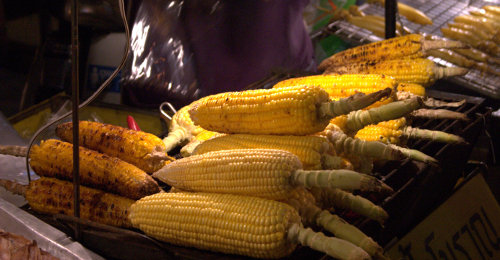I don’t think I’m unique in being bought up to think of corn as a vegetable. It wasn’t until I moved to Thailand that I found out corn was really a dessert! Fully ripe sweet yellow corn is almost exclusively found in desserts and other sweets, as well as steamed or roasted fresh corn. On the broad plaza in front of Chiang Mai’s reconstructed eastern Tapae Gate, an old lady sells roasted sweet corn. She’s there most days, unless there’s an event using the plaza, from late afternoon into the evening. The corn is roasted over warm coals. When you purchase an ear, she will dip it in butter sauce before handing it to you.

If you travel into the hills around Chiang Mai, you will likely come across some fields of corn, especially during the rainy season from May to September. Like carrots, corn is grown by the Meo villagers who live in the mountains. They are one of many ethic groups commonly referred to as “hill tribes” in the guide books. Most of the corn will be taken down to Chiang Mai and sold in the Muang Mai wholesale market once it is ripe. Some of the corn, especially ears that aren’t quite up to size, will be sold at road side stalls that you will find if you travel through the hills. The sellers will steam the corn without removing the husks and silk. For these simple country folk, “nature’s packaging” is the best. Customers buy a few ears, peel the husks back and eat the corn right off the cob. A half dozen ears may set you back as much as 25 U.S. cents.
While fully ripe sweet corn is popular as a dessert in Thailand, baby corn is what most people think of when you mention Thai food. The small undeveloped whole cobs are used in everything from curries to stir-fries. As most people know, corn is a New World vegetable, so it must have come to Thailand at about the same time as the chili pepper. There is no tradition regarding why Thais began eating baby corn. It is probably simply because the small cobs are crunchy and not too sweet. Whatever the reason, cultivating baby corn is much more labor intensive than growing the corn to maturity. Farmers must remove the tassels from the ears to prevent them from being pollinated.